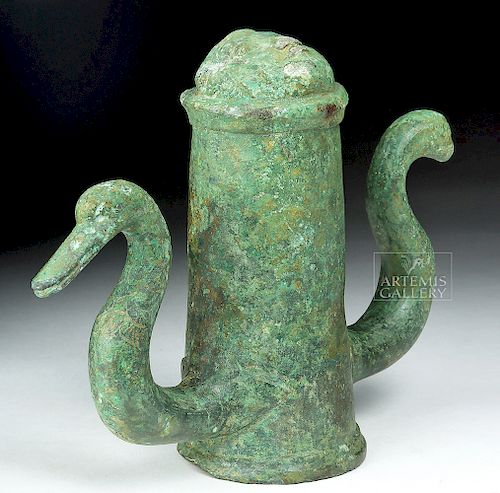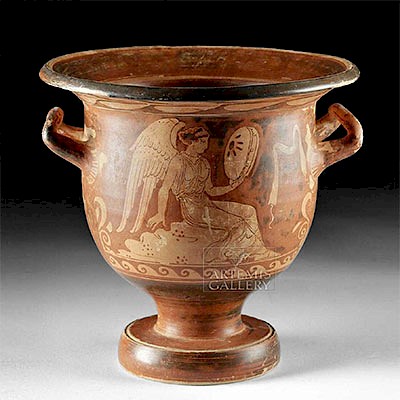Roman Bronze Chariot Mount w/ Swans & Face
Lot 53
About Seller
Artemis Fine Arts
686 S Taylor Ave, Ste 106
Louisville, CO 80027
United States
Selling antiquities, ancient and ethnographic art online since 1993, Artemis Gallery specializes in Classical Antiquities (Egyptian, Greek, Roman, Near Eastern), Asian, Pre-Columbian, African / Tribal / Oceanographic art. Our extensive inventory includes pottery, stone, metal, wood, glass and textil...Read more
Estimate:
$4,000 - $6,000
Absentee vs Live bid
Two ways to bid:
- Leave a max absentee bid and the platform will bid on your behalf up to your maximum bid during the live auction.
- Bid live during the auction and your bids will be submitted real-time to the auctioneer.
Bid Increments
| Price | Bid Increment |
|---|---|
| $0 | $25 |
| $300 | $50 |
| $1,000 | $100 |
| $2,000 | $250 |
| $5,000 | $500 |
| $10,000 | $1,000 |
| $20,000 | $2,500 |
| $50,000 | $5,000 |
| $100,000 | $10,000 |
| $200,000 | $20,000 |
About Auction
By Artemis Fine Arts
Mar 7, 2019
Set Reminder
2019-03-07 10:00:00
2019-03-07 10:00:00
America/New_York
Bidsquare
Bidsquare : VARIETY SALE | Antiquities & Ethnographic Art
https://www.bidsquare.com/auctions/artemis-gallery/variety-sale-antiquities-ethnographic-art-3928
Around the world & back in time - be amazed at the treasures you will find. Antiquities from Egypt, Greece, Italy and the Near East, Asian, Pre-Columbian, African / Tribal / Oceanic, Native American, Spanish Colonial, Russian Icons, Fine Art, much more! Artemis Fine Arts info@artemisgallery.com
Around the world & back in time - be amazed at the treasures you will find. Antiquities from Egypt, Greece, Italy and the Near East, Asian, Pre-Columbian, African / Tribal / Oceanic, Native American, Spanish Colonial, Russian Icons, Fine Art, much more! Artemis Fine Arts info@artemisgallery.com
- Lot Description
Roman, Imperial period, ca. 1st to 4th century CE. A large cast bronze chariot mount with decorative swan heads and necks forming its arms around a wide, tapering column capped by a relief human face. The face has childlike features and parted hair, demonstrating a high level of detail; the remaining swan head is less detailed, more of a functional form with an added face than a specific sculpture. The column is hollow, allowing it to be attached to the top of a chariot. Reins would be placed through the curves of the swans' necks before passing through individual terrets (rings for guiding them) for each horse. Size: 7.55" W x 5.4" H (19.2 cm x 13.7 cm)
Roman chariots were not used for warfare, but instead in circuses and in triumphal processions. As a result, elaborate attachments like this became de rigeur, lending a unique look to each chariot, where they were mounted on posts above each wheel. The carriage was supported by leather straps wrapped around the shaft and guided by the projecting arms. This absorbed the vibrations of the wooden wheels, making the ride smoother. Imagine the sun flashing off of the dark, polished bronze that this would have had when made!
This piece at the Metropolitan Museum of Art is more ornate, but shows a similar form: https://www.metmuseum.org/art/collection/search/468204
Provenance: private Houston, Texas, USA collection
All items legal to buy/sell under U.S. Statute covering cultural patrimony Code 2600, CHAPTER 14, and are guaranteed to be as described or your money back.
A Certificate of Authenticity will accompany all winning bids.
We ship worldwide and handle all shipping in-house for your convenience.
#133013One swan beak is lost, as shown. The rest of the item has some small nicks and chips commensurate with age. Pretty mottled turquoise patina on surface.Condition
- Shipping Info
-
All shipping is handled in-house for your convenience. Your invoice from Artemis Gallery will include shipping calculation instructions. If in doubt, please inquire BEFORE bidding for estimated shipping costs for individual items.
-
- Buyer's Premium



 EUR
EUR CAD
CAD AUD
AUD GBP
GBP MXN
MXN HKD
HKD CNY
CNY MYR
MYR SEK
SEK SGD
SGD CHF
CHF THB
THB

















